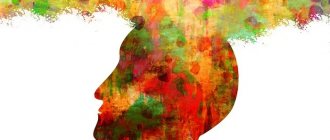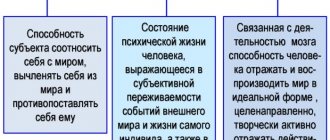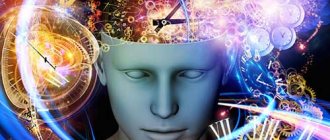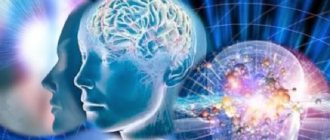Forms of social consciousness are divided according to a number of characteristics: the subject of reflection of the real world, the method of interpretation and functions in society. Moreover, each form has its own degree of correlation between the theoretical and everyday practical levels, aspects of ideology and psychology.
Forms of social consciousness
Forms within which a person feels like an individual, a social being, through which his views on society and nature are formed.
They are closely related to the standard of living, institutionalization, the process of cognition, social relations (economic, political, scientific)
Properties of consciousness
There are several basic psychological properties in the human mind:
- Consciousness is characterized by activity. In the process of practical, transformative activity, a person reflects the external world, therefore consciousness is also characterized as a spiritual activity aimed at an active, creative transformation of reality. The activity of consciousness will also be characteristic of social consciousness, for example, progressive ideas that, having mastered the masses, become “material force”;
- Intentionality of the subject's consciousness. In other words, this is a focus on any object, not necessarily on the object of the material world or any specific object. This may be the awareness of some fact, thought at the moment of communication with another subject;
- Consciousness is characterized by constant reflection or a process of continuous introspection in the subject;
- Motivational-value nature of consciousness. This means that a real subject always strives for some goal, even if the goal is the absence of a goal;
- Integrity of consciousness. The general holistic consciousness includes the unconscious, subconscious, conscious, superconscious. All these components are inextricably linked and simultaneously manifest themselves to varying degrees, which depends on the specific mental activity;
- The generalization and abstraction of consciousness manifests itself when it operates with non-real objects and phenomena of the surrounding world;
- Selectivity of consciousness or its focus only on a specific object, and not on the whole world as a whole;
- The dynamism of consciousness or its changeability and ability for continuous development;
- Distortion of consciousness, which manifests itself in the fact that consciousness always reflects reality in a distorted form;
- The uniqueness and individuality of consciousness lies in the fact that the consciousness of each individual person is different from the consciousness of other people.
Consciousness arises only in real, living, thinking subjects and belongs to the realm of the ideal, because images, sensations, and meanings cannot be considered as material objects.
Features of social and individual consciousness
The essence of social consciousness is formed on the basis of the consciousness of individual people, and at the same time is not simply the result of their summation. This is due to the fact that each individual consciousness is unique and inimitable, and can be fundamentally different from the creation of another person.
The essence of a person’s individual consciousness lies in its diversity and individuality. Individual consciousness is always brighter than public consciousness, but at the same time it is narrower in its worldview and covers a smaller scale of issues and problems under consideration.
Individual human consciousness is not capable of achieving the depth and content inherent in social consciousness. This is due to the fact that public consciousness covers all aspects of the spiritual life of society. It should be noted, however, that there is a mutual connection between social and individual consciousness, for social consciousness draws its depth and breadth of contemplation precisely from the experience of each person in his individual consciousness.
Social consciousness is always a product of individual consciousness. But, on the other hand, individual consciousness is always largely a product of social consciousness.
Values and their role in human life
Values are the object of a separate philosophical discipline called axiology. It determines the cultural value of individual things depending on how important they are in the formation of special connections between people, how they act as a unifying factor in the process of historical development of society. Values are the embodiment of social solidarity of people; when they are eroded or destroyed, the destruction of the very moral and political core of society is manifested. The consequences of this are the most negative: an increase in crime and lawlessness, an increase in immorality and immoral behavior.
Values exist only in human society; this concept cannot be used in relation to the natural world. They appear only under the influence of the development of human culture and are designed to fill a person’s life with a certain spiritual meaning and significance. The highest level of this meaningfulness is the formation of certain ideals. The simplest division of values involves the separation of such values as spiritual and material.
In spiritual values it is customary to distinguish:
- legal;
- moral;
- religious;
- political;
- aesthetic and other values.
According to another division principle, all values can be divided into:
- individual and public (social);
- actually existing and declared;
- absolute (“values-goals”) and instrumental (“values-means”).
Values are a system of reference points on which a person builds his life. A person himself decides what will be sacred for him and what is unworthy of him, although, of course, his choice is largely influenced by current cultural attitudes. However, how valuable his inner world will be filled depends only on the specific individual. The totality of such highest values ultimately determines the meaning of all human life and reveals the true purpose of man.
The destiny to seek the meaning of one’s life belongs only to value consciousness, capable of high spiritual search and feat.
Problems and prospects for the development of modern civilization. Globalization and its role in the life of society.
It is customary to distinguish several stages in the development of human civilization:
- pre-industrial society, which was dominated by the production of agricultural products based on the use of manual labor, as well as handicrafts;
- industrial society, the main economic characteristic of which is industrial production;
— post-industrial society, the main characteristic of which is the priority development of the service sector, which begins to prevail over the volume of industrial production (the beginning of the formation of this type of society dates back to the middle of the twentieth century);
- an information and technology society in which the production of information, its technical support and the provision of information services prevail over all other types of socio-economic activity of people (the transition to this type is characteristic of modern civilization).
Modern society is characterized by the following features:
1) unprecedented scientific and technological progress and the associated sharp acceleration in the pace of social development;
2) the scale and radicality of the changes taking place in the world and in the life of society;
3) increasing anthropogenic influence on nature: in the modern world, human capabilities are comparable to the forces of nature;
4) steady population growth:
- by the beginning of our era there were about 200 million people on Earth,
- after 13 centuries this number doubled (400 million),
- at the beginning of the 19th century. – 800 million (it took 6 centuries to double),
- at the beginning of the twentieth century. – 1.7 billion,
- by the beginning of the 21st century. – over 5.6 billion.
5) globalization of processes occurring in the world. Globalization refers to the process of unifying all spheres of human activity on the scale of all humanity. This process covers economics, technology, trade, culture, and political institutions.
The processes of globalization are objective; they are caused by the peculiarities of the current stage of social development. At the same time, they carry many contradictions.
On the one hand, globalization has led to the expansion of connections between states and peoples in all spheres of life (a striking example of this is the international crews of spaceships); to the formation of a number of international organizations whose activities are aimed at jointly solving the problems and problems of modern humanity (among them the UN, whose goal is to maintain and strengthen peace, security and development of cooperation between states (it includes about 200 states); the EEC, its main the task is economic development and strengthening cooperation between European countries; the Club of Rome is an international organization of scientists and businessmen created to study the problems and prospects for the development of mankind in the era of scientific and technological progress, etc.).
On the other hand, currently the processes of globalization are directed by world banks and financial corporations, which has led to the polarization of society: to a deepening of the gap between wealth and poverty, to the dominance of individual countries in the world community (according to scientists, currently 15% of the planet's population dictate their will to the remaining 85%). This caused, on the one hand, the phenomenon of international terrorism, and on the other, the anti-globalization movement. In addition, the focus on economic progress and an increase in material standards has led to the loss of humanitarian values and to the spiritual crisis of modern society.
The contradictions of globalization have caused the emergence of a number of global problems - affecting not individual countries and regions, but humanity as a whole and requiring the combined efforts of the entire world community to be solved.
All global problems can be divided into three groups:
1) problems generated by the relationship between society and nature and associated with the limited ability of the natural environment to withstand anthropogenic loads (environmental problem, problem of raw materials and energy resources, etc.);
2) problems related to relations between states and peoples (the problem of world wars and the threat of thermonuclear catastrophe, etc.);
3) problems based on the relationship between the individual and society (demographic problem, problems of public health and education, etc.).
One of the most pressing global problems is environmental , which combines a wide range of issues affecting various aspects of the relationship between society and the natural environment: protection of water and air basins, soil protection, conservation of flora and fauna, the impact of a polluted environment on human health, etc. A special place in this series is occupied by socio-ecological problems, which involve the development of an optimal strategy in the relationship between society and nature, the formation of environmental consciousness.
In modern science, a new discipline is being formed - global studies. This is a science that studies the most general patterns of human development and constructs models of a controlled, viable world. Global studies dictates the need for a universal, planetary approach to solving the problems of modern society. The main question of global studies is to determine the limits of the ability of the biosphere to withstand the loads of anthropogenic impact.
Global studies defines the main task of modern society as the transition to a noospheric civilization, i.e. controlled by the human mind, a scientifically and spiritually organized stage of human development in conditions of limited capabilities of the natural environment. As a basis for the transition to a new stage of development, a model of sustainable development , which is designed to ensure a balance between meeting the economic needs of society, increasing the level of its material well-being and preserving the environment.
Philosophical theories
From a philosophical point of view, consciousness is the ability to relate and realize an object (according to Hegel). This word refers to a person's fundamental ability to relate to the world as a whole. This is the form or method of an object, the type and way of representing the universe. The understanding of conscious activity always exists, it has no beginning and end, cannot disappear, just like the world itself. Consciousness and the universe are two sides of a single correlation. Therefore, in a philosophical sense, it would be wrong to consider it as a separate concept; it is inseparable from the essence of the world.
Conscious essence is not the ability to relate, it is the relation itself. This argument follows from the fact that a person is not able to be detached from it, to go beyond its boundaries. We are consumed by this substance. Without it, nothing exists for a person. On this side, the term implies duality and division within. This means that consciousness is international (according to Husserl).
Philosophers are trying to find an explanation for the conclusion that the essence of consciousness proclaims the separation of subject and object, internal and external Self and the universe. In a relative form, this is a certain experience that relates us to the world. This experience implies the process of correlation itself in general and in the form of a person’s experience of this process. Therefore, in philosophy, the subject is distinguished from the concept of conscious essence. The term itself is understood as the relationship between the subjective and the objective. The object is perceived by the subject.
Conscious being exists as a potential position into which the subject can fall at any time in the form of experience correlated with the universe.
melhisedek
Gradually we begin to understand that events happen to us so that we learn. We finally realize that how we are treated is directly related to how we treat ourselves. Life helps us become cleaner.
Sometimes, a person who strongly identifies himself with a particular point of view needs, very much needs, a serious life crisis, so that he realizes that there is another view of the world, less energy-consuming and more productive.
When faced with our vulnerability, we abandon it and reconsider our views, the subconscious fears that we had previously implanted in ourselves. Each of us has our own view of the world. Our vision is influenced by fears and expectations, beliefs and convictions, ideals and abominations.
This is not something we have to live with, it is best to choose a positive outlook on the world that allows us to trust, love and feel connected to all that is. We have power over our perceptions. It is God’s gift to learn to catch yourself generating negativity and direct your thoughts or situation in a positive direction before this condition creates problems.
We are operated by three forms of intelligence:
| At the superconscious level | At the subconscious level | At the level of consciousness |
| 1.Love | Fear | Will choice point |
| 2.Unity, grace | Separation, defense \attack\ | Point of view\focus |
| 3. Wisdom, truth | Ignorance | Point of identification |
| 4.Completeness, complete perception | Partial perception | Who am I? I am these \labels\ |
| 5.Collective consciousness | Isolated consciousness | Assumption of the existence of personality |
| 6.Trust support | Doubts, attachment | Window to the world |
| 7.Creativity | Survival, strong beliefs | Source of Duality |
| 8.Freedom | Polarity, conflict | Architect of earthly existence |
| 9.Memory of love | Memory of Fear | No memory |
| 10.Divine | Material | Personal |
The superconscious and subconscious are the experiences through which we look at the world. They act as storage facilities for different types of memory.
Consciousness is the place where conscious choice occurs, which creates our reality.
Our general consciousness is the instrument of free will and the point at which choice occurs and controls our everyday reality. The attitudes and ideas we perceive determine how people and situations will manifest to us.
Superconsciousness is love, the divinity of life.
Subconscious blocks in the form of negative information are our teachers, fate, karma, the source of suffering, our fears and divisions.
Consciousness is a reflection of what is happening and a choice. Even if there is nothing, the choice is still there and it is sacred.
During the operation of the superconscious we feel pleasure. During the period of activity of the subconscious, we begin to twitch, worry, and get irritated.
Sensations that are determined by consciousness
| 1 | SUBCONSCIOUS=FEAR | SUPERCONSCIOUS=LOVE |
| 2 | REACTION | RESPONSE |
| 3 | PROTECTION | RESEARCH |
| 4 | AGGRESSION, AVOIDANCE | COMMUNICATION |
| 5 | STABILITY | OPENNESS |
| 6 | NEGATION | ADOPTION |
| 7 | ANXIETY, DOUBTS | LUCK, OPTIMISM |
| 8 | STRESS, DEPRESSION | DELIGHT, CALM |
| 9 | RESTLESS, BORED | INTERESTED, INSPIRED |
| 10 | LIMITED, ACCUMULATING | WIDE, GENEROUS |
| 11 | SEPARATE | CONNECTED |
| 12 | PARTIAL, INCOMPLETE | WHOLE, FULL |
| 13 | UNCONSCIOUS WANDERING | ATTENTIVE, CHEERFUL |
| 14 | ATTACHMENTS | FREEDOM |
| 15 | CAN'T START OR STOP | FLEXIBLE, FLUID |
| 16 | ACCUSES, PUNISHES | UNDERSTANDS FORGIVES |
| 17 | MARTYR, TYRANT | IS ABLE TO SERVE, ACCEPTS SERVICES |
| 18 | IN THE PAST OR IN FUTURE | IN NOW |
| 19 | IT SHOULD BE, SUCH DESTINY | THIS IS SO NEEDED BY ME IF YOU CHANGE, IT WILL BE EVEN BETTER |
| 20 | I HAVE NO________ I CAN'T__________ | I HAVE POSSIBILITIES |
| 21 | NO TIME, NO STRENGTH, PLACES | HAS EVERYTHING YOU NEED PLACE OF POWER AND TIME |
SUPERCONSCIOUSNESS is the clear, collective consciousness of all living sentient beings. Perfect synchronicity, relevance, timeliness and sufficiency, coordination. He is not familiar with obstacles, blocks, ignorance, fears.
This part of us knows more than our certified personality, sees the whole picture of what is happening as a whole, believes, trusts, loves. The superconscious contains information about our actions at all times, about all our abilities, talents and orientation.
SUBCONSCIOUS - primitive - created, it contains information related to survival, myth-making and archetypes. It contains information about those moments when we reacted, obeying the instinct of survival and making decisions partially aware of our greatness, without understanding the situation as a whole, without having the opportunity to look from the point of view of a higher being.
Fear, panic, self-defense, doubt and mistrust are the characteristics of such memories, which makes them explosive and we do not want to touch them. Each subconscious memory is an incomplete sensation that our soul was not able to fully feel, experience and learn from.
These are black spots on the human energy field. Such memories in the West are called subconscious blocks, in the East they are called karma, among the Slavic peoples they are called fate. The subconscious is the concentration of our dark side and it is from there that negative emotions come.
CONSCIOUSNESS – has no memory and knows nothing. It is the vantage point, the eye of the soul and its senses. Consciousness is the conductor of the will, the point of choice and determination of personality, gives a sense of being and determines them, displays them in the memory of the subconscious or superconscious. It is the architect of our existence and the acquirer of experience. Consciousness is rational, separates and divides, creates a connection, association, belief, gives sensations of the personal, attaches logical labels.
All types of consciousness are important for our evolution and are very valuable and pleasant if they are consciously controlled by a person’s Spiritual Control. Any excess will lead to disqualification of energy and destruction of the object that caused the imbalance.
I AM Victory, who has come to you this day! I AM the Cosmic Being Mighty Victory! And because I AM Victory, I am victorious!
The entire evolution of the universe is doomed to Victory. And you need to develop the quality of victoriousness or victory in yourself. You simply need this quality. Because throughout the entire period of the musty history of mankind, it was precisely the quality of victory, victoriousness that you always lacked.
Perhaps what you mean by Victory is not at all the quality that I mean. Because in your dual world, each Divine quality has its own antipode. And the quality of Divine victory corresponds to the non-divine quality of victory over someone. But I have come to teach you the affirmation of victory.
It is when you renounce any human shortcomings and low-quality conditions that you gain your victory over the unreal manifestation and affirm Divinity in yourself.
And I have come to remind you of your Divine origin and the need to gain victory over your unreal part. Over millions of years of wandering around your world, you have become too accustomed to the unreal part of yourself. However, no one can force you to give up your unreal part. This is a decision you must make in your own heart.
You must strive towards Divinity and you must give up unreality. Because without this, your further evolutionary development in this universe is impossible. And if earlier we came and simply told you about the old man and the other, true man hidden in you, now the time for talking is over , and you must begin to take concrete actions that free you from the duality of illusion and direct you to the unity of the Divine world.
Believe me, all illusory manifestation is concentrated only in your consciousness, and you must overcome this illusory consciousness of yours. There is no other way. And how this can be done, the way to overcome your illusory manifestation, makes up a large part of the Teaching that is given to you through our messenger.
You need to make it a rule and begin every day to analyze those manifestations of unreality within you that interfere and hinder your victory. Try to abstract yourself from the world that surrounds you, and imagine that you suddenly find yourself in another world, the Divine.
In this world there are no forms that are familiar to you, in this world there is nothing that needs to be done with your hands. In this world there is no need to take care of the body. This is the Fiery World. A world where fiery thoughts dominate, a world created by the power of thought and existing thanks to Divine Love, which alone fills the entire free space of the Fiery World. Thanks to this Love this world exists.
Now imagine what of what surrounds you in your world that you might need in our Divine world?
Will you need things around you, money, luxury items, food, clothing? No, you will not need any of the things I have listed in our world. Then what remains?
What can continue to stay with you in our world?
I will tell you. In our world, only your Divine qualities can continue to remain with you. Selflessness, devotion, love, compassion, divine mercy, purity... There are so many qualities in the Divine world that you can keep to yourself, but in order for you to have these qualities, you must develop them in your physical, manifested world.
Otherwise, when the time comes to return to the Father’s House, you will find yourself in it without your shining clothes in the form of your virtues. It is not right to walk naked in the Divine world. You will constantly experience the sympathetic glances of the inhabitants of the Divine World.
And you will feel uncomfortable for spending time aimlessly during your earthly incarnations. Therefore, based on the description of the Divine world that you receive in our messages, find strength and courage in yourself, and part with your purely human qualities, and try to acquire Divine qualities and perfections.
Everything that is good in your world is not so in the Divine world. But there is a place in your world for the manifestation of Divine qualities. And these are the states that you sometimes experience in the form of a feeling of self-sacrifice, divine compassion, unconditional love.
Each of you at least once in your life was capable of experiencing such states of consciousness. All you have to do is remember these moments and try to spread them in your life for as long as possible. Thus, so that your whole life becomes consisting of high, sublime, Divine states of consciousness.
I come to remind you once again of your Divinity. Because in your hustle and bustle of the day, you are too divorced from reality. It's time to remember your true Home and your Divine purpose. Don't be afraid to look funny in the eyes of the people around you.
Let's see who will laugh when you get into Divine reality. And if I tell you that the cycles are shortening and time has accelerated, then this means that you do not have much time left for your experimentation in the physical world. Hurry up. Because what can be easily achieved by you when you are incarnated in the physical world is impossible to achieve during your stay in the Divine world.
In view of the density of the manifested world, any action in this world gives an almost lightning-fast result. And in order to achieve the same effect when you are in the Fiery World, you will need millions of years.
Our worlds complement each other and what is possible in your world is impossible in ours. Unfortunately, you'll have to take my word for it. Because in order to reach the world in which I live, you will need millions of millions of earthly years.
However, I do not lose hope that there will be those human individuals for whom every word of my message today will carry such an important energetic and informational component that your life will change as quickly as you could not even imagine in your wildest dreams.
I wish you to develop the quality of Victory and strive for your Divine victory with all your being!
Psychology of consciousness
Elements of consciousness are sensations, ideas, feelings.
Consciousness is the result of a creative synthesis of the basic processes of the psyche:
- the process of direct reflection of objective reality by the senses (perception)
- an active process through which consciousness realizes its potential for self-organization at a qualitatively different level than the simple sum of its elements and leads to the formation of meaningful and ordered sets of mental elements (apperception).
Structuralists
V. Wundt and the structuralists sought the nature of consciousness in consciousness itself: they tried to decompose it into elements and build a “chemistry of the soul” - something like the Periodic Table of Elements for consciousness. However, it turned out that an unambiguous solution to this problem is impossible - primarily because the identification of elements of consciousness depends on the initial position of the carriers of consciousness trying to analyze its content. But even if it were possible to overcome such methodological difficulties, it would still remain unclear: how is new knowledge formed in the mind - is it really just a new combination of standard elements?
Functionalists
Consciousness, according to James, is a vital function of a person living in a complex environment. James introduced the “personal” dimension of consciousness, believing that conscious experience is always experienced as “mine,” as “belonging to me.” W. James and the functionalists derived the nature of consciousness from the biological needs of the organism: consciousness is needed because it is useful, because it solves biologically important problems. They were objected to the fact that without conscious control, the body sometimes acts faster and more accurately and, in general, solves adaptation problems better. At the same time, W. James understood the limited capabilities of consciousness: “Consciousness is a small island in the middle of the great ocean of possibilities of the human psyche.” He eventually came to the conclusion that consciousness is a fiction that does not exist in reality.
What philosophers say
Philosophers believed that consciousness does not exist in isolation from reality. It is the relationship of oneself with reality.
We see the world around us and feel, perceive, think, and fantasize something in connection with it.
Different directions of philosophy interpreted this concept in their own way:
- dualism tends to divide man into consciousness and matter, where the first is spirit, the second is body. Consciousness is eternal, since it continues to live even after the physical death of the body;
- According to idealism, consciousness comes first, then the surrounding world. Matter does not exist if it is unconscious;
- materialists wrote that only highly organized matter, which is capable of creation, has consciousness (I understand that we are talking about a person).
Forms of social consciousness
Various ways of intellectual and spiritual acquisition of knowledge about the surrounding reality are forms of social consciousness. Let's look at these forms in more detail.
- Political consciousness includes a system of knowledge and assessments with the help of which society forms the political sphere. It is the basis for all other forms of social consciousness, due to the fact that it reflects the political and economic interests of various classes and social groups.
- Legal consciousness includes a system of knowledge and assessments with the help of which awareness in the field of law occurs in society. This type of social consciousness is closely related to political consciousness; therefore, in this form of consciousness both the political and economic interests of various classes and social groups find their manifestation.
- Moral consciousness is expressed in the historically developing principles of morality in relations between people, between people and society, between people and the law.
- Aesthetic consciousness is a person’s conscious reflection of the world around him, which occurs in the form of complex experiences. These experiences are associated with a person’s feelings of beauty, tragedy, sublime and comic.
- Religious consciousness is expressed in the internal experience of a person, which is associated with a person’s feeling of the existing connection between himself and something higher. Religious consciousness interacts with other forms of social consciousness, and, above all, with such as moral consciousness.
- Economic consciousness is a form of social consciousness that reflects the economic knowledge of society and its socio-economic needs.
- Moral consciousness, a philosophical concept that is the core of the human personality, his spirituality and everything that is the essence of man and distinguishes him from animals. The peculiarity of moral consciousness is that it is with its help that the reflection and regulation of interpersonal relationships occurs, in which each person is a mirror of the other.
Consciousness as a function of the human brain
Modern science proceeds from the ideas of the biological unity of animals and humans. From this, conclusions are sometimes drawn about the complete analogy of mental processes in humans and animals. But human consciousness arose and developed in close dependence on the formation and development of the human brain, as indicated by the fact that the level of complexity of the organization of the brain depends on the level of the reflexive ability of consciousness.
The main function of the human brain is the storage and processing of information that a person receives in the process of cognitive activity. The human brain is symmetrical (hemispheres), but there is a big difference between the hemispheres in terms of functionality.
The left hemisphere is responsible for all types of language activity (understanding, speech), ensures the processes of speech and writing, reading, performs counting operations, and assigns an object to certain classes.
The right hemisphere controls orientation in one's own body (perception of spatial relationships, correct coordination).
Consciousness not only reflects reality, but also allows us to express certain relationships with it. Therefore, the structure of consciousness includes: memory, emotions, feeling, will, motivation.
Ideal Properties of Consciousness
- perception;
- comprehension;
- grade;
- memory;
- fantasizing;
- life experience
- opposite to the material object of which it is an image (fire - the image of fire);
- regardless of matter (in consciousness, what is possible is possible in the real world);
- in some cases, it is primary in relation to matter (when making any object, there is always an “image” of this object in the mind);
- not perceived by the senses (has no smell, taste, color, does not have extension, etc.)
Consciousness as such is structurally organized, representing an integral organic system consisting of many components that are interconnected in diverse connections.
The purpose of self-awareness of a person’s personality
It is not easy to control the mind. This is why many spiritual teachings recommend meditation practices to calm the voices in the head and bring the psyche into a state of complete concentration. In Indian philosophy this state is called samadhi, “concentrated mind.”
It is said that when the mind is concentrated, then a person can realize his true Self. The nature of this “I,” according to ancient Vedic teachings, is sat-chit-ananda.
Sat – “truth, immutability, eternity, being.” This is something that does not depend on our experience, something that has always been and will be.
Chit – “knowledge”. This is the very ability of consciousness. It is the development that makes experience possible.
Ananda - "bliss". A world that surpasses all understanding and lies beyond all thought. It is the state of grace from relationships with other living beings that we strive to return to.
Structure of consciousness
Note 1
Consciousness is one of the most complex objects of study, since it does not have its own qualitative specificity. The specificity of consciousness is determined by those mental processes and phenomena that fill it, but are not themselves consciousness.
So consciousness is filled:
- sensory images, as the results of the processes of perception and sensation;
- thought chains, concepts, ideas that arise in the course and as a result of thinking;
- images of the past extracted from the past;
- affects, reflecting the emotional reaction to real and imaginary stimuli;
- desires, reflecting needs and motives;
- the experience of readiness/unreadiness for activity, depending on the involvement of volitional processes;
- subjective assessments reflecting cognitive attitudes and motivation systems, etc.
In consciousness, all these components are presented as if simultaneously, and as a rule, one of them comes to the fore, depending on the concentration of the individual’s attention on certain processes. And although it is impossible to imagine consciousness or the psyche without these processes, their study does not allow us to say anything about consciousness itself. Nevertheless, attempts to structurize consciousness are still being made. So V.P. Zinchenko identifies three layers of consciousness:
- existential consciousness,
- reflective consciousness
- self-awareness.
Existential consciousness is an outer layer, focused primarily on reflecting the surrounding reality; its content consists of sensory images and the biodynamic experience of the individual in interaction with the environment. Reflective consciousness, in turn, is focused on reflecting the actual mental intellectual-affective processes; its content includes meanings and meanings.
Existential and reflective consciousness support the functioning of self-consciousness as the highest level of development of consciousness as such. Self-awareness performs the most important function of permanent self-identification of the psyche, allowing it to connect units of experience into a coherent personal history of a person, to form an image of the Self, an idea of oneself, one’s properties and qualities, which forms the basis of decision-making systems, the formation of goals and needs, and forecasting the future.
Everyday and scientific understanding of consciousness
Consciousness is a multi-valued concept that is defined and understood differently in philosophy, psychology and everyday life. And although the content of consciousness in these three areas turns out to be qualitatively different in content, in practice they are often mixed up, which entails various incidents. For example, when scientific facts about consciousness begin to be interpreted from the point of view of its philosophical or everyday understanding.
From an ordinary point of view, consciousness is understood as the entire conscious part of the psyche, i.e. the entire layer of internal mental life that is accessible to the “I” of the individual for direct observation and is associated with it. In reality, at the everyday level, there is a confusion of ideas about consciousness and self-awareness.
Self-consciousness, as the highest and specifically human form of consciousness, has such a specific property as self-identification, i.e. It is thanks to self-awareness that a person realizes himself as a person, he forms an image of himself, his past experience is formalized as memories and forms a certain life story, which allows not only to correlate present conditions with the past, but also to build forecasts regarding the present, to create ideals and dreams.
Consciousness as a form of reflection of the external and internal world, from the point of view of psychological science, is practically not directly experienced by a person; in the process of reflection, it tightly merges with self-consciousness and is practically inseparable from it, although a person can record changes in his consciousness upon the onset of his altered states, such as vague states of consciousness (stupefaction, darkness, loss), alcohol and drug intoxication, affect, expansion of consciousness when using meditative and trance practices.
In addition, in ontogenesis, the emergence of consciousness precedes the emergence of self-awareness. Self-awareness develops in a child between the ages of 2 and 3.5 years, which can be noted by such signs as:
- recognizing yourself in the mirror,
- recognizing yourself in photographs,
- using the pronoun “I” instead of referring to oneself in the third person (“Petya wants to eat”),
- forming first memories.
At the same time, holistic consciousness arises already at 7-8 months of age and is finally formed by the first year of life. Moreover, despite the holistic nature of the reflection of the surrounding world, the child does not yet isolate himself from it as an independent unit - a subject of activity and a source of activity, and also does not localize his affective experiences, sensations and needs within his body. Lack of self-awareness is one of the reasons that memories of a given age are not formed, and many people’s “early” memories (of the age before two years) are induced, i.e. arisen on the basis of relatives about their behavior in early childhood.
It should be noted that if self-consciousness is considered as a specifically human form of mental organization, then consciousness is also characteristic of higher animals, which allows them to grasp complex relationships between objects in the surrounding world and solve complex problems that require achieving an intermediate result (for example, connecting two tubes to each other in order to get the tool of the required length and reach the treat).
The concept of consciousness in philosophy
The development of ideas about consciousness can be indirectly considered starting from the period of antiquity. Indirectly due to the fact that in this period philosophers did not directly talk about consciousness using terms such as soul, spirit, idea to describe the human psyche.
So Plato viewed the human soul as an idea that for some reason was placed in a material body. At the same time, the idea of the soul went far beyond the immaterial part of human essence; the idea was understood much more globally, as a substance, i.e. the true reality and fundamental principle of the world. It is for this reason that the soul was considered immortal, because the substance is eternal and unchanging, it cannot disappear.
The further development of ideas about the soul and consciousness in philosophy took place in this vein, despite all the diversity of their forms. So, for example, Democritus, who adhered to materialistic views, understood the human soul as an accumulation of a special kind of atoms. Democritus asserted the mortality of the soul of a particular person as the disintegration of a certain structure, formed from its atoms in the body of a particular person, but the atoms of the spirit themselves not only had substantial properties, but also permeated all of nature, giving the property of life to its numerous manifestations.
Aristotle took a synthetic position, believing that the soul has a complex structure and the part of it that is attached to the memories, feelings and desires of an individual person is mortal, but the highest part of the soul - abstract thinking, is a reflection of the universal mind, and therefore is substantial and immortal.
The doctrine of the immortality of the soul continued to develop in the Middle Ages. The highest substance that determines the appearance and content of reality began to be associated with God. The human soul, in turn, received from him the same substantial qualities; moreover, a dualistic understanding of man was formed, divided into base, material and temporary, i.e. body and the highest, ideal and eternal – the soul. The human soul also continued to be considered in an extrapersonal context, as a metaphysical, general philosophical concept.
In modern times, the term soul was replaced by consciousness itself. Consciousness personified the entire sphere of a person’s mental life - sensation, memory and thinking, but was not limited to them, and also had a substantial basis. For Descartes, consciousness is a manifestation of the substance of the spirit; in Leibniz’s concept, consciousness is one of the monad substances, etc. It is precisely as a substance that consciousness is considered in modern philosophical teachings.
Dialectics of consciousness and being
In classical and post-classical philosophy, the dualism of soul and body grew into the problem of the dialectics of consciousness and being, their correlation, mutual position and cause-and-effect relationships. Two main approaches to solving this problem have been formed:
- idealistic,
- materialistic.
Representatives of the idealistic approach defend the existence of consciousness as an independent substance, as well as its primacy, or equality in relation to matter. Thus, for Kant, consciousness and matter exist in parallel and independently of each other, from which he concludes that the world of things is, in principle, not cognizable for consciousness, and therefore the image of the world that a person builds depends entirely on his consciousness in the first place . Within the framework of the concepts of subjective idealism, the illusory nature of the material world as such is postulated, and the reality of only human consciousness is affirmed.
Materialist teachings, in particular Marxism, proceed from the position that reality is matter. Matter can take various forms, it is characterized by movement and development, during which an intangible product can arise as a result of material functions. From this position, consciousness is also considered - as a product of the functioning of highly organized matter, which evolved along with matter in the course of socio-historical development.
Origin and essence of consciousness. Reflection and Consciousness
In the history of the development of philosophical knowledge, there are 3 points of view about the origin of consciousness:
- Religion assumes that consciousness is a manifestation of an immaterial substance, the soul does not depend on the brain and is capable of independent existence, it is immortal and eternal;
- Idealists believe that consciousness is primary in comparison with matter, it is the independent essence of the original activity;
- Materialists rely on the idea that consciousness is a subjective image of the objective world.
Dialectical materialism approaches the question of the origin of consciousness historically and asserts that all matter has the property of reflection.
Reflection is the ability of material systems to reproduce in themselves the properties of other material objects that interact with them. This is a property of both living and inanimate nature.
Elementary forms of reflection (do not have activity):
- mechanical
- physical
- Chemical substance
A special type of reflection is biological, which includes several stages: 1) irritability; 2) sensitivity; 3) mental reflection (its most complex form is consciousness).
Irritability is a pre-psychic form of reflection; it is the reaction of living beings to favorable and unfavorable environmental conditions. A higher form of irritability is sensitivity, i.e. the ability to reflect certain properties of things in the form of feelings, and the need for self-preservation arises (a purposeful reaction begins - for example, in plants). Animals develop their abilities, which they already actively use in search of food. This is the basis for the further development of the biological form of reflection, i.e. the origin of the mental form of reflection.
Perceptions and ideas arise as a result of the complication of real forms of behavior, as well as the development of the nervous system and brain structures.
Mental reflection, which originated in vertebrates, is the property of living beings to adequately respond to the materialized environment in order to adapt behavior.
Mental reflection is the systematization of sensations, the ability of living beings to model behavior in order to adapt to the environment. It is also the ability to repeatedly respond to standard and non-standard situations that arise and find the right way out of them.
The highest form of mental reflection (and reflection in general) is consciousness, and according to the materialist concept, consciousness is the ability of highly organized matter (the brain) to reflect matter.
Literature
- Vasiliev V.V.
The difficult problem of consciousness. - M.: Progress-Tradition, 2009. - 272 p. — ISBN 5-89826-316-0. - Priest S.
Theories of consciousness / trans. from English A.F. Gryaznova. — M.: Idea-Press: House of Intellectuals. book., 2000. - 287 p. - Andreeva L.
Ecstatic rituals in the practices of some Russian confessions or altered forms of consciousness // Social sciences and modernity. - 2005. - No. 3. - Morozov E.V.
Evolution of consciousness. Modern science and ancient teachings. - M.: New Acropolis, 2013. - 370 p. — ISBN 978-5-91896-048-6. - Nalimov V.V.
Spontaneity of consciousness. - M., 1989. - Penrose R.
Shadows of the Mind. In search of a science of consciousness. - M.: Izhevsk, 2005. - Rubinstein S. L.
Being and consciousness. - M., 1957 - Spirkin A.G.
Consciousness and self-awareness. - M., 1972 - Shentsev M.V.
Information model of memory. - St. Petersburg, 2005. - Tart Ch.
T. States of Consciousness. — New York, 1975.
Forms of human consciousness
Human consciousness has several stages of development and forms of manifestation. Let's take a closer look at the available forms of consciousness. Classical psychology distinguishes two main forms of consciousness - social consciousness and individual human consciousness.
Social consciousness is the totality of all ideas, views and assessments inherent in a particular society at a certain stage of its development.
Individual consciousness is the totality of all ideas, views and feelings inherent in a particular person.
Forms and types
In the psychology of consciousness there are different types of perception of reality: adequate and inadequate. An adequate form is called an objective perception of the surrounding world. A person in an adequate state has the ability to speak meaningfully, quickly responds to changes, and easily navigates space.
Inappropriate types of perception:
Unclear - the individual is detached from the world around him and does not react to other people. Doesn't answer questions, or does it slowly, at random
Attention is dulled, movements are slow. Stupor - a person behaves as if he was awakened from a deep sleep. He is inhibited, lethargic, speaks unintelligibly, is not interested in communication, and often looks at one point. Dullness - a person completely withdraws into himself, spending most of his time sleeping
When he wakes up, he cannot understand where he is, he cannot tell what he was doing before he fell asleep. Coma is a state of deep sleep from which a person cannot be awakened. He does not react to sounds, touches, and does not evaluate what is happening. Coma is a medical phenomenon. Doctors cannot find a way to prevent coma and a way out of it. The patient can only wake up on his own; this is impossible to control. Delusion is a distorted perception of reality. A person loses the ability to think adequately and cannot explain his behavior and actions. Hallucinations are intrusive visual and auditory distortions. A person sees and hears something that is not really there. Regular hallucinations give rise to distrust of others, anxiety, and a paranoid state.
Forms of consciousness differ in focus:
- individual - it contains personal characteristics, values, ideas.
- social - includes customs and traditions characteristic of a particular culture;
- theoretical level of social consciousness - connects public ideologies with reality;
- ordinary - responsible for a person’s behavior in ordinary life;
- mass - combines the knowledge of a person as an individual and the component of the crowd.
Types of consciousness in psychology:
- public - formed by society;
- historical - created by the background influence of the common past of humanity;
- political - a view of the world formed under the influence of political sentiments in the country and the world.
Development occurs linearly. You cannot skip a stage of development.
Structure, properties and functions of consciousness
Structure is what consciousness actually consists of:
- Cognitive processes - perception of the surrounding world through 5 senses (eyes, ears, nose, tongue, mouth), memory, thinking, speech.
- Spectrum of emotional states.
- Will as the ability to control one's actions.
Properties
Consciousness can be described by two main properties:
- Activity – implies the continuity of the process of awareness of reality (stream of consciousness). At every moment of time (and even in a dream), a person is focused on something. The world is huge and diverse, so items are chosen according to their degree of personal significance.
For example, if you sit next to a hungry person and someone dying of thirst, put plates of food and glasses of drinks in front of them, the first will look at the food, the second - the drink. Anyone who dreams of children will notice children everywhere. Anyone planning to buy a car turns their attention to a car of the desired brand.Each individual captures in space what is relevant to him at a given moment in time. That is why the attention of different people focuses on completely different figures.
- Intentionality is direction, desire, attraction.
If you observe yourself from the outside (engage in reflection), you will see that your thoughts are always directed somewhere: towards a goal, an object, an action. For example, in the discussion about the red mug above, my thoughts were directed towards tea drinking.
Functions of consciousness
Consciousness has its own functions, the main ones being:
- The reflective function is the organization of mental processes (memory, thinking, perception, representation) aimed at understanding the surrounding world.
- Creative or creative - creating something new.
- Evaluative - we evaluate everything that we are aware of, we give it an emotional and sensory assessment.
- The transformative function is to build certain goals and translate them into reality through actions. That is, we are transforming the world around us.
- Time-forming - the formation of a general picture of the world, where there is a past, present and future.
- Reflexive function or self-awareness is the ability to observe oneself as if from the outside, to evaluate one’s thoughts and behavior.









